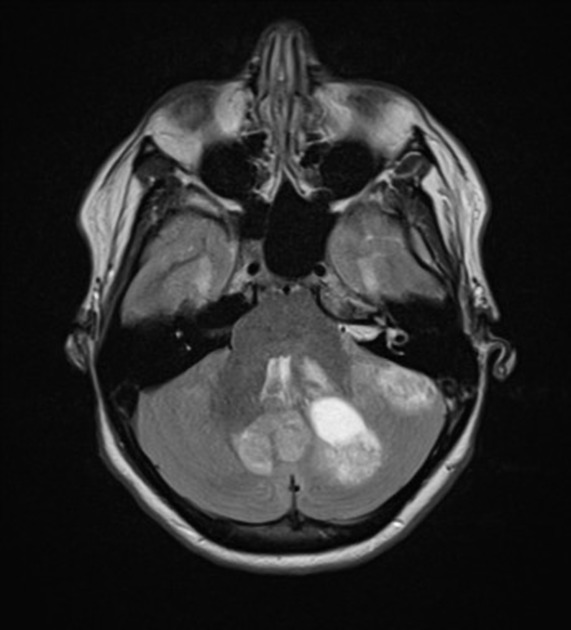Medulloblastoma (SHH subgroup)





Medulloblastoma - sonic hedgehog (SHH) subgroup tumors are malignant tumors of the central nervous system. They are the second most common medulloblastoma subgroup (after group 4) and are approximately as common as group 3. They are found most commonly in adults and infants, but infrequently in children. Although they can arise from the vermis of the cerebellum, as is typical for group 3 and 4, they are most frequently located laterally within the cerebellar hemispheres.
Epidemiology
SHH subgroup tumors account for approximately 27% of all medulloblastomas, and, unlike group 3 and 4, have no particular predilection for males, with a ~1:1 male to female ratio .
They are most frequently encountered in adults (>16 years) and infants (<4 years) but are uncommon in children .
Pathology
SHH medulloblastomas can demonstrate various histologies, with classic, large cell/anaplastic and desmoplastic/nodular/medulloblastoma with extensive nodularity (MBEN) all encountered .
Importantly, almost all desmoplastic/nodular/medulloblastoma with extensive nodularity (MBEN) tumors are SHH subtype .
Recently subtypes of SHH have been defined and termed SHHα, SHHβ, SHHγ and SHH∆ :
- SHHα: typically in children with TP53 mutations
- SHHβ: typically in infants, poor prognosis
- SHHγ: typically in infants, good prognosis
- SHH∆: typically in adults with TERT promoter gene mutations
Radiographic features
The radiographic features of SHH subgroup tumors are variable, to a degree depending on histological subtype.
When they are of classic or large cell/anaplastic histology and located in the midline, they are essentially indistinguishable from group 3 and group 4 tumors .
The desmoplastic/nodular/medulloblastoma with extensive nodularity (MBEN) tumors, on the other hand, tend to occur in the lateral parts of the cerebellar hemispheres .
For more details on radiographic features, please refer to the general article on medulloblastoma.
Treatment and prognosis
Surgery is the first line of therapy (as is the case in all subgroups) with the aim being histological proof, molecular subtyping and maximal tumor resection, with adjuvant therapy depending on an overall risk profile (see general article on medulloblastoma) .
The incidence of CNS metastatic disease in the SHH subgroup at diagnosis is relatively common in infants (17%) and children (22%) but is uncommon in adults .
SHH tumors have intermediate prognosis compared to other subtypes of medulloblastoma; that is, better than group 3 tumors, but significantly worse than WNT subtypes. Prognosis is also strongly influenced by age :
- 77% 10-year overall survival in infants
- 51% 10-year overall survival in children
- 35% 10-year overall survival in adults
Prognosis is also influenced by histological subtype, with extensive desmoplastic and nodular subtype - dominating SHH medulloblastomas in infants - probably accounting for the improved survival .

